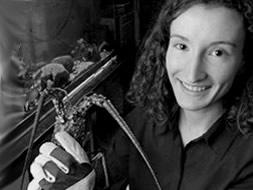
Sheila Patek
Why you should listen
Sheila Patek, a UC Berkeley biologist, made a name for herself by measuring the hyperfast movements of snail-smashing mantis shrimp heels and bug-snapping ant jaws, using high-speed video cameras recording at up to 20,000 frames per second. In 2004, she and her team showed that peacock mantis shrimp had the fastest feeding strike in the animal kingdom, and that they are the only known animal to store energy in a hyperbolic paraboloid, a super-strong Pringles-shaped structure more often found in modern architecture.
Then in 2006, she and her team announced that trap-jaw ants had stolen the title of fastest striker from the mantis shrimp, when their research measured the ants' snapping jaws at an awesome 78 to 145 miles per hour, accelerating at 100,000 times the force of gravity. Patek's previous research focused on the sounds made by spiny lobsters, discovering that they used a mechanism similar to a violin. In 2004, she was named one of Popular Science magazine's "Brilliant 10." The Patek Lab at University of Massachusetts Amherst, where Patek is the principal investigator, continues to explore evolutionary questions through the integration of physiology, biomechanics, evolutionary analysis and animal behavior.
What others say
“[Sheila] Patek has parsed the mechanics of the odd antenna twitches that lobsters use to make noise and is helping develop a physiology-based method to predict what each lobster species would sound like. Recently, she proved that the peacock mantis shrimp has the fastest kick in the animal kingdom.” — Popular Science
